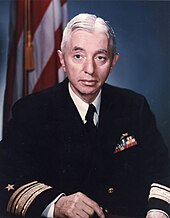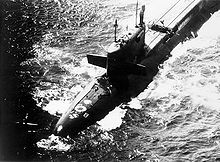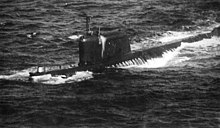Nuclear submarine

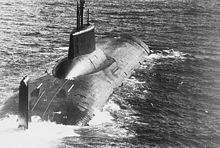
A nuclear submarine is a submarine that draws the energy for its propulsion system and its on-board systems from one or more nuclear reactors , see: nuclear energy propulsion . With the American USS Nautilus (SSN-571) , the first nuclear submarine was put into service on September 30, 1954. There are currently six nations operating nuclear powered boats; these are the United States of America , Russia , France , Great Britain , the People's Republic of China and India .
Compared to the mostly smaller and cheaper submarines with conventional drives, such as diesel-electric propulsion , nuclear submarines have the main advantage of an almost unlimited range and the fact that with nuclear submarines the duration of the dives is practically only is limited by the food supplies on board.
history
Development history
The development of the nuclear submarines began after the end of the Second World War in the United States . The American physicist Philip Hauge Abelson dealt with maritime propulsion technology and, in this context, also with the possibility of accommodating a reactor in a submarine. At the same time, the United States Atomic Energy Commission and the Bureau of Ships of the United States Navy were active in this area . In these authorities, the later admiral and so-called "father of the nuclear navy" Hyman Rickover pursued the idea of a nuclear-powered submarine. On the basis of Abelson's research results, a group led by Alvin M. Weinberg finally designed a reactor for submarines. The United States Congress finally approved the construction of a first, fully operational prototype for the Navy in July 1951. Under Rickover's direction, the world's first nuclear submarine, the USS Nautilus (SSN-571) , was built by 1954 . On January 17, 1955, the Nautilus cast off the pier for the first time using nuclear propulsion. In the summer of 1958, it demonstrated the advantages of its new propulsion system with the first crossing under the North Pole. The USS Triton (SSN-586) was the first submarine to circumnavigate the earth completely underwater in 1960.
The Soviet Union also developed a number of nuclear submarines. A corresponding decree was signed at the end of 1952; reactors had been under development for some time under the direction of Nikolai Dolleschal . The first Soviet nuclear submarine, the Leninsky Komsomol , was built in the Severodvinsk shipyard from September 1955 and was first powered by nuclear power in the summer of 1958. The boat with the tactical number K-3 crossed under the North Pole four years later than the Nautilus in 1962.
In 1969, the smallest nuclear submarine was launched at Electric Boat . The only nuclear-powered research submarine NR-1 , only around 45 meters long to date , was also commissioned by Hyman Rickover.
Classification
Nuclear submarines were used in essentially three different roles in the years that followed. The names follow the nomenclature of the US Navy and NATO .
So-called attack and hunting submarines are referred to as Ship Submersible Nuclear or SSN for short (in German, for example: " Submersible ship with nuclear propulsion"). Their main task is the secret tracking of enemy submarines as well as operations near the enemy coast, among other things for electronic monitoring or the detachment of special forces, whereby a quiet underwater journey is particularly important in order not to be noticed by enemy sonar .
Ship Submersible Ballistic Nuclear or SSBN for short (German about: Submersible ship with nuclear propulsion and ballistic missiles) are submarines that can carry and shoot ballistic missiles that can be launched underwater . These SSBN usually travel in the vastness of the oceans in order to be inaccessible to the enemy in the event of an enemy nuclear first strike . Thus they represent the most important part of the second strike capacity .
A Ship Submersible Guided Missile Nuclear or SSGN for short (German about: Submersible ship with nuclear propulsion and cruise missiles) carries cruise missiles and / or anti-ship missiles . The task of this type consists in tactical attacks on aircraft carrier combat groups and land targets.
Mission history
United States
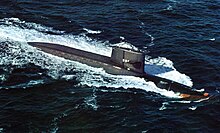
After the completion of the Nautilus and a second prototype, the USS Seawolf (SSN-575) , serial production of four boats began in the USA with the skate class in the mid-1950s . All of these boats still had the classic wedge-shaped bow designed for cruising on the surface of the water. Around 1960 the US Navy first used the hydrodynamically optimized Albacore hull in the form of a teardrop with the Skipjack class , which allowed speeds of up to 30 knots , which was around 50% higher than the speed of the first US nuclear submarines. At the same time, the first missile submarines were developed. The George Washington class was still a modified Skipjack hull, but the later boats of the Ethan Allen and Lafayette classes were already independent designs.
In the 1960s, the US Navy finally rethought. The focus was no longer on speed, but rather low noise emission while driving. From this the Thresher and Sturgeon classes developed . In the 1970s, the submarines were planned, which will still form the backbone of the United States' submarine fleet in the 21st century. These are the Los Angeles class of hunting submarines and the Ohio class of the SSBN. It was only after the end of the Cold War that more hunting submarines were completed. These units of the Seawolf classes, and especially Virginia, are today among the most modern nuclear submarines in the world.
The first dedicated SSGN did not emerge until the 21st century as a result of the Ohio-class rebuilding . Until then, only SSN of the Los Angeles class equipped with vertical launching systems had fulfilled this task.
The last diesel-electric powered boats of the Barbel class were built in parallel to the skate class in the 1950s and went out of service around 1990. Following this class, the US Navy relied exclusively on nuclear submarines. In 2012 there were 71 nuclear submarines, 14 of them SSBN and four SSGN, in the US Navy fleet. The peak numbers were around 140 active nuclear submarines from the mid-1960s.
Soviet Union / Russia
The Soviet Navy moved rather quickly in replenishing the nuclear submarine fleet after the completion of the first nuclear submarine, the Leninsky Komsomol . Between 1958 and the mid-1960s, she built twelve more boats from Project 627 , which also included K-3 , as well as eight Hotel-class SSBNs and 34 Project 659 SSGNs . This rapid development, which should lead to the numerical catching up of the Soviet Union to the USA, was at the expense of more precise tests and trials of the boats and reactors, so that a second generation soon had to follow, which could perform better than the first boats. But because only a few shipyards were able to develop and complete the difficult-to-build nuclear submarines, the construction of conventionally powered boats continued in the Soviet Union.
Many nuclear submarines continued to be built in the 1960s and 1970s. More modern SSBN of the classes Project 667A and Project 667B followed, the production of the latter continued in a modified version until 1992. SSN of the Victor class and SSGN of the Charlie class were also manufactured. By the 1990s, 142 boats of these two classes had been completed. In the last ten years of the Soviet Union, the world's largest submarines were put into service with the boats from Project 941 , and more modern SSNs of the Sierra and Akula classes and SSGNs of the Oscar class followed . These submarines were taken over by the Russian Navy and some of them continued to be produced. The SSGN of Project 885 and the SSBN of Project 955 , which are currently in production, were then developed under Russian aegis .
For 2012, the size of the Russian nuclear submarine fleet is estimated at around 30, including 15 SSN, 10 SSBN and five SSGN. In addition to nuclear submarines, the Russian Navy also operates modern, conventionally powered boats of the Kilo and Lada classes .
Great Britain
The Royal Navy had already researched the technology after the Second World War, but never decided to actually build nuclear submarines. It wasn't until the Nautilus' capabilities became known that the UK began planning. The British finally joined the circle of nuclear submarine powers in 1963 with the commissioning of their first boat, the HMS Dreadnought (S101) . Under the First Sea Lord Louis Mountbatten , American reactor technology was fitted into a British hull. The Valiant class was soon followed by the first completely British SSN, and the first SSBN with the Resolution class in the 1960s. The Royal Navy continued to order conventional submarines.
Two more SSN classes followed in the 1970s, namely the Churchill class consisting of three boats and the Swiftsure class, which is twice as large . The more modern Trafalgar class finally came to the fleet in the 1980s . As of 1993, four new SSBNs belonging to the Vanguard class were put into service . Currently under construction are the Astute-class boats, which are gradually replacing the Trafalgars . The type ship was put into service in 2010.
In 1994 the Upholder class, which was only a few months old, was the last diesel-electric submarine of the Royal Navy to go out of service, so that the British Navy now also has an exclusively nuclear-powered submarine fleet. In 2012 the size of the fleet was seven SSN and four SSBN.
France
The French Navy has been using nuclear submarines since the Le Redoutable was commissioned in 1971, initially only as part of the nuclear armed forces . The French developed the propulsion system completely on their own, with no help from other countries. By 1980 the Le Redoutable was followed by five further SSBNs of the Redoutable class , in 1985 the classless boat L'Inflexible . Until 1983, the French were all conventionally powered hunting submarines, but then by 1993 the six boats of the Rubis and Améthyste classes were added to the fleet.
New SSBNs have been under construction since 1997, the Triomphant class comprises four boats and replaces the old SSBN. As a replacement for the SSN, the Barracuda class is planned, which is to receive six units by 2026.
In 2001 the last diesel-electric submarine was taken out of service. The size of the French submarine fleet in 2012 is therefore six SSN and four SSBN.
China
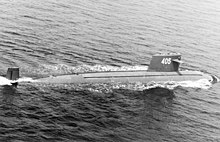
The navy of the People's Liberation Army is the penultimate armed force before India to build nuclear submarines, although relatively little is known about their boats. The planning program started in the late 1950s and a request to the Soviet Union for help was rejected. As a result, it took years before results were visible: Between 1974 and 1991, the five SSN of the Han class went into service. From 1981 the first SSBN of the People's Republic went into service, as far as is known, two Xias were built, one of which could have been lost later, the other seems to be still in service. At least one source also reports the loss of a Han .
In the 21st century, China's first new SSN was launched with the Shang class (Type 093), and further boats of the improved Type 095 class are planned. How big this class will be is unknown. As with the new Jin-class SSBN (Type 094), the first boat of which appears to be in service, this time Russian shipyards and designers played an important role in the construction of the submarines.
The exact size of the Chinese submarine fleet is not known due to inaccurate and dubious, sometimes contradicting information, but in 2011 it should be in the single-digit range and consists of boats of the Jin and Shang classes. It is unclear whether older boats are still in service. This means that the Chinese fleet of diesel-electric submarines, which come from their own, Soviet and Russian production, is significantly larger in number. In 2011 it was around 60.
India
India itself started the Advanced Technology Vessel (ATV) program as early as 1985 , which aims to build its own nuclear submarines. Between 1988 and 1991 the Navy deployed a Charlie-class boat leased by the Soviet Union . The boat K-43 , known in the Indian Navy as the INS Chakra , was controlled by Soviet sailors who trained the Indians. In addition, there have been media reports about the leasing of two Russian Akula-class submarines since the turn of the millennium . In January 2012 the Indian Navy took over a recently completed boat from the Russian Navy for ten years. This belongs to the Akula II class and is again called the INS Chakra in India . The cost will amount to $ 650 million.
In July 2009, the INS Arihant was launched as a result of the ATV program. On August 10, 2013, the reactor was brought into critical condition .
Drive technology
General
Technically speaking, there is little difference between conventional and nuclear submarines. With the French Rubis class it was proven that the reactor does not have to cause any substantial enlargement of the boats; At just under 73 meters, they are no larger than modern diesel-electric boats such as those in the Kilo class . However, this is rather the exception, because the reactor and the reactor shield mean a high additional weight, which is why most nuclear submarines are over 100 meters long.
A nuclear -powered submarine has a nuclear reactor such as that used on land in nuclear power plants, albeit much smaller because it has to fit into a shell with a diameter of less than ten meters. The reactor heats a liquid in the radioactive primary circuit. This in turn gives off its heat in a heat exchanger to ultrapure water in the non-radioactive secondary circuit. The resulting high-pressure steam drives a turbine. A generator connected to this turbine converts the mechanical energy into electrical energy for the on-board systems and charges batteries, which also provide energy in the event of a reactor failure. With the turbo-electric drive , the propeller shaft is driven by an electric motor. More often, however, a geared turbine is used, which drives the shaft directly with the energy of the turbine.
Today's submarines only use pressurized water reactors . Both the USA on the Seawolf and the Soviet Union with the Alfa class have also experimented with liquid metal-cooled reactors. While the Americans soon replaced the sodium-cooled reactor with a pressurized water reactor due to major safety concerns, the Soviet Union, which used a lead-bismuth alloy for cooling, operated its six boats with liquid metal reactors for around ten years.
While the western designs only have one nuclear reactor on board, the Soviet boats in particular often had and still have two reactors, with boats with two propellers sometimes operating a separate reactor for each shaft. On the other hand, the second reactor can also serve as an emergency reserve. Today's submarine reactors have an output of around 150 megawatts .
Advantages and disadvantages
Diesel-electric powered submarines get their energy from the fuel they carry. Large batteries are charged by means of diesel generators , which supply the drive motors and on-board systems with electricity during dives. In order to recharge the batteries, fresh air for the diesel engines must be sucked in from the surface of the water by surfacing or a snorkel , whereby the risk of localization is particularly high. Deviating from this is only the case with modern patterns with non-nuclear independent outside air propulsion methods, such as drives by fuel cells as the German class 212 A implemented. However, these units also have to be refueled after a comparatively short time.
The reactor of a nuclear submarine, on the other hand, can be filled with nuclear fuel for several years. Because the air on board is prepared for breathing, nuclear submarines can remain at great depths as long as there is food for the crew on board. The duration that a submarine spends under water is therefore primarily limited by the human factor. In addition, energy does not have to be used on nuclear submarines; they are thus able to maintain high speeds over the long term.
However, there are also disadvantages. While a diesel-electric boat is almost silent when traveling with a pure electric drive powered by the batteries at low speed, the nuclear reactor always makes minimal noise. In particular, the coolant pumps, which maintain the circulation of the reactor coolant, play a role here and can be detected by enemy sonar . In the case of some nuclear submarines, such as the Ohio class , the cooling of the reactor can, however, be ensured by natural convection even without pumping at low load regimes . Nuclear submarines also always generate perceptible thermal radiation.
Mission profile
Nuclear submarines are mainly used for blue water operations , i.e. for missions beyond the continental shelf . In the vastness of the oceans, they can exploit their permanently higher speed and their long underwater endurance far better than in the flat, narrow coastal areas.
The SSN's areas of responsibility are the protection of so-called “ big ships ”, such as aircraft carriers or amphibious assault ships , but also the hunt for enemy submarines and surface ships and the acquisition of intelligence information about the results of weapons or ship tests from another nation. SSBN, on the other hand, patrol in as remote areas as possible in order to remain undetected long enough in the event of a nuclear war and to be able to fire their ICBMs. The SSGN adopt a mixture of these strategies. They can be used to pursue and attack enemy convoys, for example, but also to wait at a great distance from the coast and to fire long- range cruise missiles at land targets.
While the US Navy used nuclear submarines on a massive scale as cruise missile platforms in the Second and Third Gulf War , the Royal Navy is the only Navy to record a sinking by a nuclear submarine: the HMS Conqueror (S48) sank the Argentine warship General Belgrano during the Falklands War . The use of SSBN has so far only been practiced in exercises.
Scrapping
Action
Nuclear submarines were manufactured in large numbers during the Cold War . Since every warship only has a limited period of use until it is sidelined by technological innovations and its own age, the problem of disposal arises. Special measures have to be taken when scrapping, since every reactor contains nuclear fuel and the entire primary cycle is heavily contaminated. These measures must therefore be carried out by specialists in special shipyards and require a large financial outlay.
Generally, the nuclear fuel and contaminated liquids are removed initially, then the reactor section is separated from the rest of the hull. This residue can be recycled normally, for example sold as scrap metal. The contaminated parts of the reactor, i.e. the reactor chamber and the pipes, then have to be stored. In the US, this is done underground at the Hanford Site , and the spent nuclear fuel is stored in the Naval Reactors Facility at Idaho National Laboratory . The cost of deactivating and dismantling a nuclear submarine was around $ 40 million for the US Navy in 1998.
The US Navy has launched the Ship-Submarine Recycling Program for the dismantling of nuclear-powered warships . As part of this program, nuclear submarines, among other things, are professionally freed of radiation-contaminated parts in the Puget Sound Naval Shipyard in Bremerton , Washington , and then demolished. By 2007, over 100 nuclear submarines had already been dismantled, 17 were waiting to go through the program. Of these 17, the last will not be canceled until 2017. Until the dismantling begins, the US boats in the reserve fleet of the United States Maritime Administration will continue to be serviced in order to avoid problems with the shutdown reactors or rusting through of the hull.
Until 2007, Great Britain had only decontaminated one of its 14 decommissioned nuclear submarines and turned it into a museum, the remaining 13, with emptied reactors, are still in storage in Rosyth and Devonport . After the nuclear fuel has been removed, France will store the reactor department in a special hall next to the dry dock in Cherbourg-Octeville for about 20 years and then want to dismantle it further.
Problems
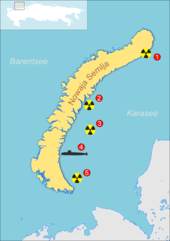
The Russian Navy, which inherited large numbers of nuclear submarines from the Soviet Navy, had and still has far greater problems with the environmentally friendly dismantling of the hulls and the final storage of the spent nuclear fuel. Since Russia could hardly raise enough money after the collapse of the Soviet Union to maintain the ships that were still seaworthy, the proper disposal of the submarines was hardly given any importance, many of them rusted in Russian naval bases. At the end of the 1990s, the Russian Navy had collected around 130 old nuclear-powered submarines, some of which had been decommissioned 20 years ago and only did not sink because of compressed air pumped into the hull and pontoons tied to the sides .
The Soviet Union had hardly taken care of the obsolete nuclear submarines, which had been decommissioned from the mid-1980s, but had spent more funds on emergency repairs on old boats and building new ones. Reactors and the used, but still radioactive nuclear fuel taken from them by boats that were dismantled were stored on the coast in partly insufficiently shielded locations. However, sometimes was in these camps is not enough space so that all the reactors, some with and some without fissile material, on the coast of the Kara Sea , mainly in the fjords of Novaya Zemlya , dumped were. Of these, up to eleven reactors still contained spent radioactive fuel elements. Among these are two experimental, liquid metal-cooled reactors from the submarine K-27 , which had a serious accident in 1968 and was completely sunk there in 1981.
In the ports of the Far East Fleet alone there are (as of 2006) 30 to 40 decommissioned nuclear submarines. To deal with this problem, Russia is now dependent on international aid. In 2006, the fleet received from Japan 171 million US dollars in order to be able to properly dispose of only five of these units. Up until 2006 alone, Russia received more than one billion US dollars from abroad for the dismantling of submarines and raised 200 million dollars itself. With this money, all decommissioned submarines will be professionally demolished by 2010. One of the largest donors is the USA with its Cooperative Threat Reduction program.
The German EWN Entsorgungswerk für Nuklearanlagen GmbH has been involved since 2003 on behalf of the Federal Ministry of Economics in the major international project disposal of Russian nuclear submarines, in which nuclear submarines laid up in north-west Russia are scrapped.
Incidents and accidents
Sunken boats
So far, seven nuclear submarines have been confirmed to have sunk, two of them from the US and five from the Soviet Union / Russia. It should be noted that some of the submarines, for example the Soviet K-429 , suffered severe water ingress, but the hull itself remained intact, the boat was later lifted. Therefore, the numbers vary depending on the source. It is also unclear whether nuclear submarines of the Chinese People's Liberation Army could have sunk.
The first ever lost nuclear submarine was the USS Thresher (SSN-593) in 1963 , which was lost in deep diving tests with the entire crew of 129 men. Five years later the second US boat sank. The cause of the explosion that occurred aboard the USS Scorpion (SSN-589) in 1968 has never been determined for sure. Today it is suspected that a defective torpedo battery could have triggered this. 99 sailors lost their lives in the process.
In 1970 a fire broke out on board the Soviet K-8 . The boat was towed while it sank with 52 men. In 1986 the fuel tank of an ICBM detonated on board the Soviet K-219 after a leak in the silo cover. The ship stayed on the surface for two days, but eventually sank. The crew could disembark beforehand. On April 7, 1989, the K-278 Komsomolets was lost after a fire, with 42 crew members perishing. In 2000, the Russian submarine K-141 Kursk sank after a torpedo explosion, and all 118 crew members died. In 2003 the last nuclear submarine to date, the K-159, was lost. The boat had already been decommissioned in 1989 and should now be towed for dismantling. During the tow, however, the boat ran full and sank with nine sailors on board. Of these five boats, only the Kursk was lifted.
A report by the International Atomic Energy Agency in September 2001 gives the results of water investigations in the region of the burial grounds of the sunken submarines. According to this, hardly any radioactive contamination was measured that did not result from the fallout of earlier nuclear weapons tests . Near the American boats only an increased level was of 60 Co measured near the Komsomolets of 137 Cs . This indicates that the reactor chambers have remained tight in all cases even after more than 40 years under water.
In addition, some sources report the loss of a Chinese Xia-grade SSBN . The American author and former naval attachée Peter Huchthausen also reports that a Han is said to have sunk in 1983 after a collision with a Soviet Victor III . According to this, the two boats collided 100 kilometers southeast of Vladivostok and the Han then sank in a kilometer deep water with their entire crew. In 1989 the Russian Academy of Sciences measured radiation values of up to 1000 roentgen per hour there. In addition, Huchthausen documents the accident with a mass of obituaries published in Chinese newspapers in the period in question for submarine designers.
Other incidents
The first-generation Soviet nuclear submarines in particular were involved in accidents that were directly related to the new type of propulsion. As early as 1961, there was a near-disaster on the K-19 , in which a meltdown could only be prevented by eight men going straight into the contaminated reactor chamber and starting an improvised emergency cooling system. After this incident, the boat was given the nickname “Hiroshima” by Soviet sailors. Until 1970 alone, after reactor problems on board five other boats, crew members were exposed to radiation so badly that they died shortly afterwards. Especially with regard to the first Soviet boats, there are reports of such low safety standards that radiation limits prescribed in Western boats were exceeded many times over. This was done primarily from a construction point of view, since the reactor shielding, which is largely made of lead, greatly increases the weight of a boat. Because of this, the early boats were very prone to problems.
But also with the Soviet boats of the later generations there were other accidents such as the outbreak of fire on board and difficulties with the maintenance or refilling of reactors. An example of the latter is the K-314 , in which an attempted replacement of the fuel assemblies in 1985 caused a violent explosion that killed 10 people and damaged the boat beyond repair.
On the part of the western navies, however, no serious incident is known that would have resulted from a reactor malfunction and would have led to the radiation of crew members. However, some minor issues have been reported. This includes problems with the dumping of depleted deposits (which has now been discontinued), as they appeared on the USS Guardfish (SSN-612) in 1975 , or the incorrect opening of valves in the primary circuit so that radioactively contaminated water can escape, as happened in 1978 on the USS buffer (SSN-652) . The Royal Navy had problems with the loss of convection in the reactor of the HMS Tireless (S88) 2000, whereupon the boat was stuck in the port of Gibraltar for a year . The 1994 explosion in the engine room of the French nuclear submarine Émeraude , which cost ten sailors their lives, had nothing to do with reactor damage or the like.
There were several collisions, especially during the Cold War, when the two superpowers spied on each other with nuclear submarines. These were regularly politically explosive, as they often occurred in national territorial waters. An example of this is the underwater collision between the American USS Tautog (SSN-639) and the Soviet K-108 , which took place in 1970 off Petropavlovsk-Kamchatsky , or that which the aforementioned K-19 in 1969 in the Barents Sea with the USS Gato ( SSN-615) . The journalists Sontag and Drew report on more than ten collisions between boats of the USSR and the USA and of two between British and Soviet submarines between 1960 and the end of the Cold War alone.
Collisions with surface vessels are also not uncommon, most notably the accidental sinking of the Japanese fishing training ship Ehime Maru by the American USS Greeneville (SSN-772) off Hawaii in 2001.
The last time there was a collision in the Atlantic in February 2009 between the French Le Triomphant (namesake of the Triomphant class ) and the British HMS Vanguard . Both ships were only slightly damaged and were able to continue their voyage on their own.
Nuclear submarines in literature
Even Jules Verne's submarine Nautilus from the novel 20,000 Leagues Under the Sea had in 1870 an outside air-independent propulsion and capabilities similar to a nuclear submarine.
The first bestseller that actually deals with nuclear submarines was made by Tom Clancy in 1984 with Hunt for Red October . The film adaptation was also a box office hit. Other authors later rode this wave, such as the Englishman Patrick Robinson or the American Clive Cussler , who published novels about nuclear submarines. Films like Crimson Tide followed and portrayed fictional scenarios; Around the turn of the millennium, films such as In the Waters of Death (via the K-219 ) or K-19 - Showdown in the Deep (via the K-19 ) finally took up real events and partially dramatized them.
literature
- Alexander Antonov, Walerie Marinin, Nikolai Walujew: Soviet-Russian nuclear submarines. Danger from below . Siegler Verlag, Sankt Augustin 2007. ISBN 978-3-87748-656-6
- Tom Clancy: Nuclear Submarine: Journey Inside a Nuclear Warship . Heyne, Munich 1997. ISBN 978-3-86047-267-5
- Andrew S. Erickson: China's Future Nuclear Submarine Force . US Naval Institute Press, Annapolis, MD. 2007. ISBN 978-1-59114-326-0 (engl.)
- Susanne Kopte: Nuclear Submarine Decomminssioning and Related Problems ( Memento from August 20, 2006 in the Internet Archive ) (PDF; 181 kB) . Bonn International Center for Conversion 1997. (Eng.)
- Norman Polmar, KJ Moore: Cold War Submarines: The Design and Construction of US and Soviet Submarines, 1945-2001 . Potomac Books, Dulles, VA 2003. ISBN 978-1-57488-594-1 (English)
- Viking O. Eriksen: Sunken nuclear submarines - a threat to the environment ?. Norwegian Univ. Press, Oslo 1990, ISBN 82-00-21019-7
Web links
- Report on the development of the Soviet / Russian nuclear submarines and accidents of the boats of the Northern Fleet by the environmental organization Bellona (English)
- A quick tour of Bellona on the rest of the nations (English)
- Sources of ionizing radiation, worldwide - Google Maps
Individual evidence
- ^ Alvin M. Weinberg: The First Nuclear Era: The Life and Times of a Technological Fixer . Springer, Berlin 1997. ISBN 978-1-56396-358-2 (English, blurb)
- ↑ Size of the US Navy fleet in the Naval Vessel Register ( Memento of the original from December 28, 2011 in the Internet Archive ) Info: The archive link has been inserted automatically and has not yet been checked. Please check the original and archive link according to the instructions and then remove this notice. (engl.)
- ↑ Annual fleet size of the US Navy by type ( Memento from December 30, 2014 in the Internet Archive ) (Eng.)
- ↑ State of the Russian Navy on warfare.ru (Eng.)
- ↑ globalsecurity.org: Han class (Engl.)
- ↑ a b Federation of American Scientists (Eng.)
- ↑ a b Peter Huchthausen: K-19 . National Geographic, Washington DC 2002; ISBN 3-934385-88-5 ; Pages 219f
- ↑ Office of the Secretary of Defense of the United States: Military and Security Developments Involving the People's Republic of China 2011 (PDF; 3.0 MB). P. 3, 34.
- ↑ India Today: The sub total (Engl.)
- ^ Rajat Pandit : Reactor of India's first indigenous nuclear submarine INS Arihant goes 'critical' , Times Of IndiaO, accessed on August 17, 2013
- ↑ Times of India: India plans to buy 6 new subs, says Navy chief (engl.)
- ↑ Kopte 1997, page 43
- ^ Samuel Loring Morison: "US Naval Battle Force Changes" in Proceedings 132 (12) pp. 59-60. ISSN 0041-798X
- ↑ a b BBC report about the sinking of the K-159 , with a map of the dumped reactors in the Novaya Zemlya region (English)
- ^ Environmental protection organization Bellona : Naval Nuclear Waste Management in Northwest Russia ( Memento of February 27, 2009 in the Internet Archive ) (engl.)
- ↑ environmental organization Bellona : Decommissioning of nuclear submarines (Engl.)
- ↑ Report from the International Atomic Energy Agency (English)
- ↑ Environmental protection organization Bellona : Japan to begin dismantling 5 subs under a Moscow-Tokyo deal ( Memento of the original from September 7, 2008 in the Internet Archive ) Info: The archive link was automatically inserted and not yet checked. Please check the original and archive link according to the instructions and then remove this notice. (engl.)
- ↑ Environmental protection organization Bellona : Russia to scrap 17 nuclear submarines this year ( Memento of July 3, 2009 in the Internet Archive ) (Engl.)
- ↑ mdw Mitteldeutscher Wirtschaftsverlag GmbH: The Atom-U_Boot project of the EWN. November 18, 2018, accessed November 23, 2018 .
- ↑ Bauernfeind, Ingo: Radioactive to all eternity - The fate of the Prinz Eugen . ES Mittler & Sohn, Hamburg / Berlin / Bonn 2011, ISBN 978-3-8132-0928-0 , p. 160 .
- ↑ IAEA: Inventory of accidents and losses at sea involving radioactive material (PDF; 3.2 MB), Section 3 (Engl.)
- ^ Sherry Sontag, Christopher Drew: Hunt under water. The real story of submarine espionage . Bertelsmann Verlag, Munich 2000. ISBN 3-570-00425-2 ; Pages 454ff
- ↑ Peter Huchthausen: K-19 . National Geographic, Washington DC 2002; ISBN 3-934385-88-5 ; Pages 214ff
- ↑ Clancy 1997, p. 72
- ↑ Peter Huchthausen: K-19 . National Geographic, Washington DC 2002; ISBN 3-934385-88-5 ; Page 220
- ^ Sherry Sontag, Christopher Drew: Hunt under water. The real story of submarine espionage . Bertelsmann Verlag, Munich 2000. ISBN 3-570-00425-2 ; Pages 445ff
- ^ Caroline Gammell, Thomas Harding: British and French nuclear submarine collision 'as serious as sinking of Kursk'. In: telegraph.co.uk. February 16, 2009, accessed August 31, 2015 .
- ↑ The Guardian: Nuclear submarines collide in Atlantic (English)

